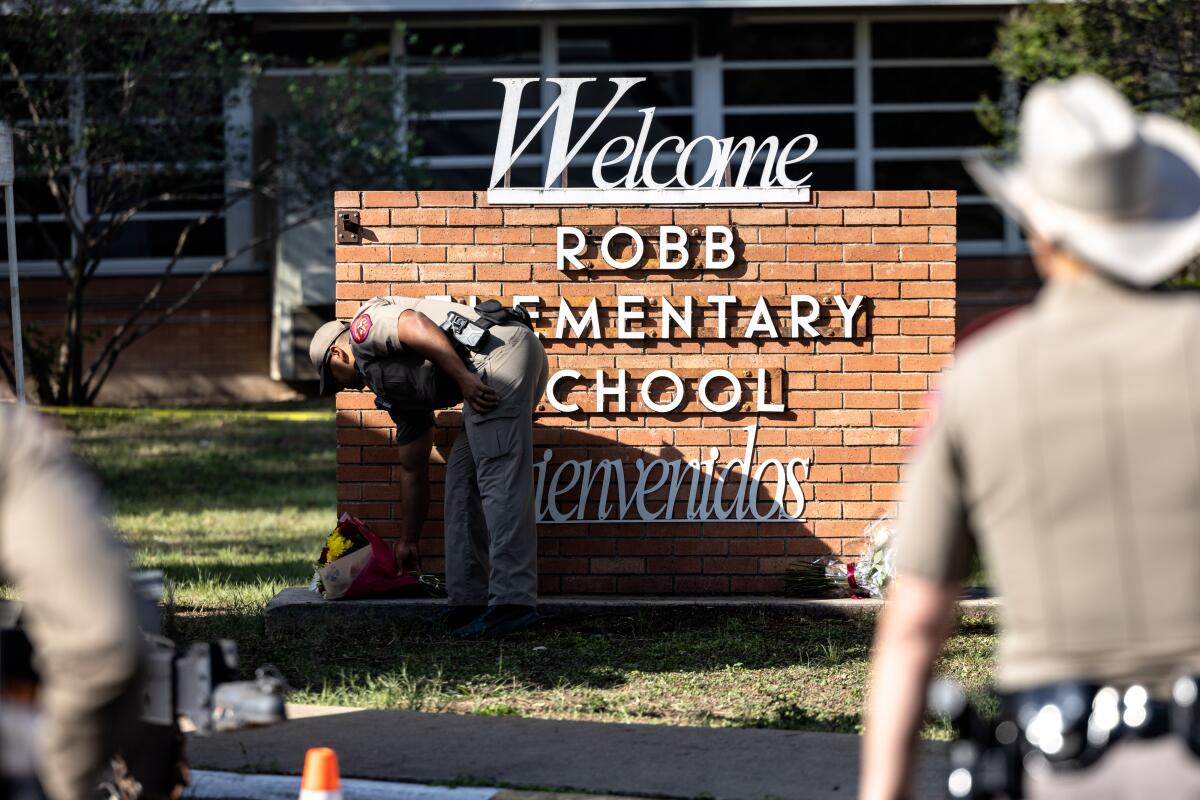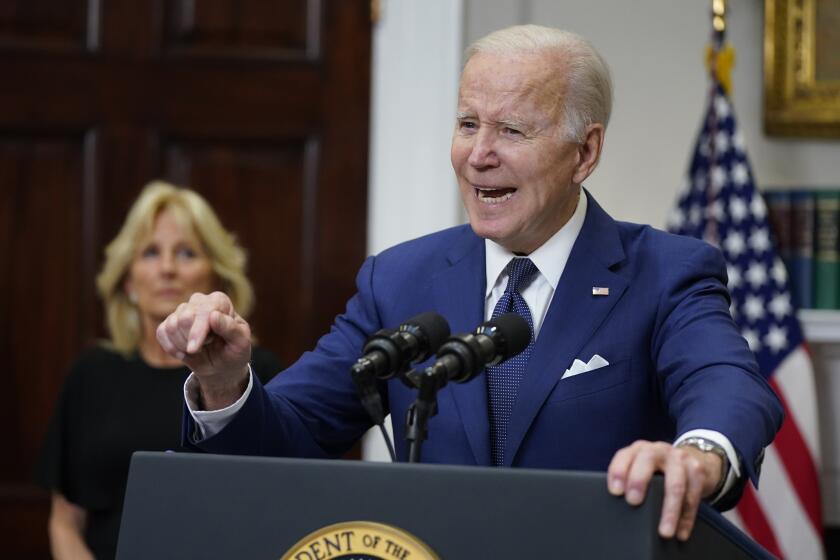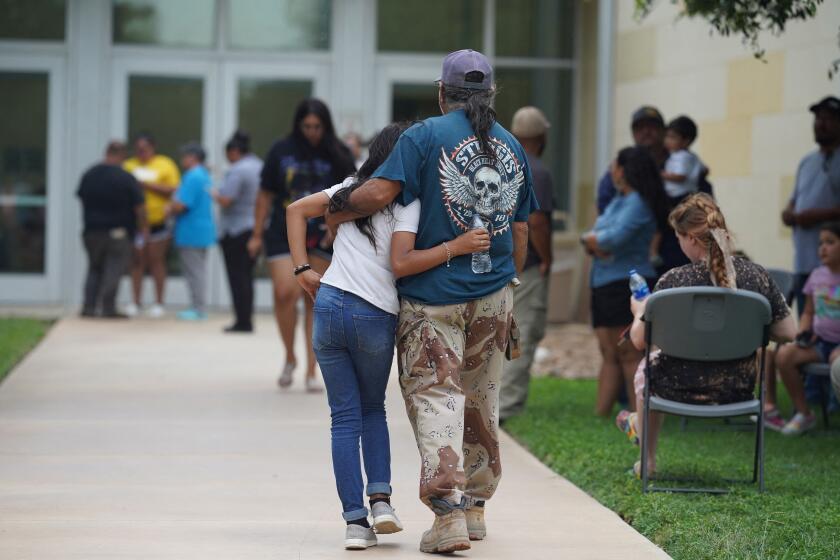Why our response to school shootings is all wrong

- Share via
“He shot and killed horrifically, incomprehensibly,” Texas Gov. Greg Abbott said, describing the actions of the 18-year-old gunman allegedly responsible for killing 19 children and two adults at Robb Elementary School in Uvalde, Texas, on Tuesday.
Horrifically? Yes. Incomprehensibly? Hardly.
Americans have come to expect such tragedies. Columbine. Red Lake. Newtown. Parkland. And now Uvalde. These town names almost immediately conjure images of children being gunned down in their classrooms.
Nicholas Goldberg: How many times has Biden said, ‘We’ve got to act’ on guns? What’s the hold up?
The Constitution may be the biggest obstacle to meaningful gun control, and in this environment, amending the Constitution is virtually impossible.
Recent analysis shows that active shootings at K-12 schools are getting worse, with a significant increase in the number of such incidents since 2017. Yet the vast majority of school shootings are preventable if we didn’t have a completely misguided approach to addressing the problem. Instead of being proactive — focusing on prevention — we are overwhelmingly reactive, with children dying as a result.
Just hours after the shooting in Uvalde, Texas Atty. Gen. Ken Paxton suggested that the best way to keep our children safe is to “arm and prepare and train teachers and other administrators.” But the success of this kind of approach, along with other “hardening” methods such as metal detectors and police presence on campus, are unproven.
The idea of arming teachers is right out of the gun lobby’s playbook. After the 2012 mass shooting at Sandy Hook Elementary School in Connecticut, the National Rifle Assn. stated “the only thing that stops a bad guy with a gun is a good guy with a gun.”
This approach is completely reactive and works only after an attack has already begun, often after people have been shot. There’s no basis for thinking this is the best way to save lives, especially in a state like Texas where firearms can be readily obtained with no permit and no training.
Perhaps it’s the fate of the United States to watch its soul die along with the 19 students and two adults shot to death Tuesday at an elementary school in Uvalde, Texas.
The presence of armed individuals — police officers, security guards, staff or private citizens — rarely dissuades active shooters from going on a rampage. The mass shooting at Robb Elementary was no exception. The alleged gunman, carrying at least one assault rifle, was reportedly confronted by a school resource officer when the gunman entered the school.
If our goal is to keep school shootings from happening in the first place, we have to prioritize prevention over after-the-fact interruption, the way we do with other forms of violence such as bombings. Our laws make it nearly impossible for bad actors to legally obtain the precursor explosives necessary for building large-scale bombs. And there are no elected officials claiming that the only way to stop a bad guy with a bomb is a good guy with a bomb.
Just as bombings require explosives, mass shootings require guns. To prevent school shootings, we need to seriously address the material threat posed by firearms, particularly when in the hands of at-risk or dangerous people, including those under the age of 21 and those with little or no training.
Column: ‘What are we doing?’ After the Texas school shooting, Sen. Chris Murphy speaks for us all
After 21 people, including 19 children, are shot to death at a school, this country must decide if it accepts a culture of self-imposed mass murder.
In his address to the nation Tuesday, President Biden argued that the path forward requires “common sense gun laws.” As he said, “We know they work and have a positive impact.” Research on gun violence confirms this. States with more guns and more permissive gun laws, on average, experience more mass shootings and more school shootings.
There is strong evidence that these specific measures could reduce horrific acts of gun violence.
- Bans on assault weapons and large-capacity magazines that hold more than 10 bullets have been shown to significantly reduce the frequency and lethality of mass shootings. In particular, when the federal assault weapons ban was in effect between 1994 and 2004, gun massacres resulting in six or more deaths fell by more than one-third. They nearly tripled after the ban expired.
- Permit-to-purchase laws are known to reduce mass shooting violence. Research shows that in states where gun purchasers are required to be licensed and fingerprinted before obtaining a firearm, mass shootings occur at a much lower rate compared to states without such policies.
- Extreme risk protection orders, also referred to as red flag laws, allow authorities or family members to petition a court if a loved one is believed to pose a threat to themselves or others, and to request that the person in question be temporarily dispossessed of their firearms. Early research around these orders is encouraging, with people who threatened to commit a mass shooting ultimately not resorting to firearm violence after being subjected to the order.
- Restrictions on the kinds of firearms those younger than 21 can purchase also offer promise. The alleged Robb Elementary gunman reportedly bought his assault rifles just a few days prior to the shooting, right after he turned 18. Approximately 20% of active shootings at K-12 schools are committed by people between 18 and 20. By limiting this age group to ownership of long guns traditionally used for hunting, mass shootings could be significantly reduced.
- Finally, as approximately 3 out of 4 school shooters who are under 18 obtain their firearms from home (or a relative’s home), safe storage and child-access-prevention laws — which require that firearms be unloaded and locked when unattended in the home — can be beneficial in preventing school shootings. Broader studies indicate that such laws also reduce gun theft, firearm suicide and unintentional shootings.
Officials need to turn to evidence-based gun restrictions, which can help save lives through prevention, and stop reacting to massacres like the one in Uvalde with rhetoric and excuses promoted by the gun lobby. If there’s one thing better for public safety than a good guy with a gun, it’s a bad guy without a gun.
Louis Klarevas is a professor at Teachers College, Columbia University, and the author of “Rampage Nation: Securing America from Mass Shootings.” @Klarevas. Sonali Rajan is a professor at Teachers College, Columbia University. @SonaliRajan. Charles Branas is a professor of epidemiology at the Mailman School of Public Health, Columbia University. @EpiProfCharlie.
More to Read
A cure for the common opinion
Get thought-provoking perspectives with our weekly newsletter.
You may occasionally receive promotional content from the Los Angeles Times.












